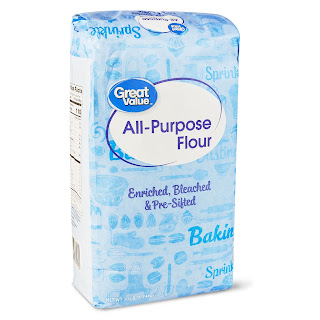In the United States, "All-Purpose Flour" has been a baking staple for many generations. All-purpose flour is not a whole flour, and only the starchy endosperm is used, without the germ and bran portion of the kernel. Hard flours contain more gluten, and soft flours contain less gluten. All-purpose flour is meant to be an intermediate between these two, suitable for most baking needs.
All-purpose flours vary regionally, based on the type of baking most often done in a particular part of the country. Generally, all-purpose flours in the Southern United States will be softer, since southerners tend to make more biscuits, and a softer flour yields a lighter, fluffier biscuit. Northern all-purpose flours have a higher proportion of hard flour.
Freshly milled flour is not white. Bleaching is a chemical process used to make the flour whiter in appearance and to improve it’s functional properties. Aging serves to naturally bleach the flour through oxygenation. However, this is a costly process, involving a great deal of storage space, labor, and a high risk of pest infestation. Chemical bleaching, such as with chlorine gas or benzoyl peroxide, is much less expensive. This bleaching lightens the flour and also improves the strength and elasticity of the gluten it contains. Unbleached all-purpose flour is only marginally darker and unbleached products are now available in most large chain grocery stores.
There is a consistent myth, reported by various sources, that chemical bleaching removes vitamins from flour, which must then be added back in through fortification. Although bleaching does destroy some additional vitamin B6 and folic acid, it is the milling process itself, which removes the nutritious bran germ, that is the reason white flours began to be fortified.
Today consumers have many choices other than the traditional All-Purpose flour. Here are some other readily available flours that you may want to give a try. They offer not only some variety in taste but an extra nutrition boost as well.
Whole wheat flour retains the germ and bran
portion of the kernel and so is higher in fiber as well as vitamins B-1, B-3, and B-5, along with riboflavin and folate. It also
has more iron, calcium, protein, and other nutrients than white flour. Its cooking properties are similar to All-Purpose flour.
Rye Flour. Rye is a rich, hearty grain that has been consumed for centuries. Rye flour nutrition differs from wheat flour and often packs more of a nutrition punch, especially if you opt for the dark variety, which holds more potent health benefits. Rye is not gluten free, however rye flour contains much less gluten than wheat and barley. Besides a distinctive bread, rye flour is also used as a filler for sauces, soups and custard powder and in pancake flour in the United States, and for making gingerbread in France.
Oat Flour. Oats - once thought of as suitable only for animal feed and Scotsmen - are one of the healthiest grains on planet Earth. The are packed with protein, B vitamins, minerals and fiber. Unlike many other flours, oat flour is gluten free. It is heavier and denser than wheat flour and a good choice for pancakes, cookies and quick breads.
You may also find flour made from beans and nuts. Most groceries stores have a pretty good section these days.




No comments:
Post a Comment